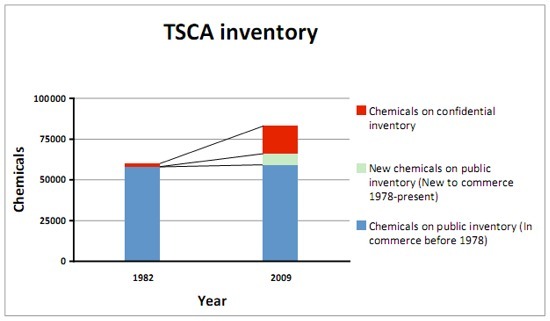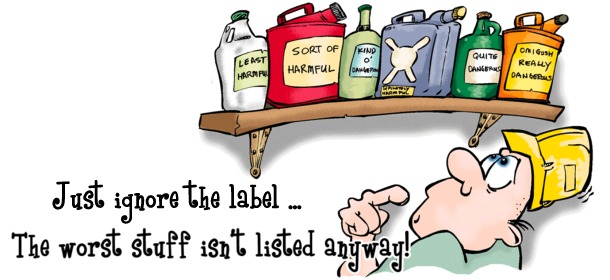Environment
Law Says Don’t List Chemicals If It Hurts Corporate Profits
The Toxic Substances Control Act sorta kinda requires that new chemicals be declared before marketing – but only if the disclosure won’t harm profits!
Chemical manufacturers’ trade secrets take precedence over safety in the United States. That’s not mere speculation. It’s the law. The 1976 Toxic Substances Control Act (TSCA) supposedly requires chemical companies to inform the government of any new chemicals they’re planning to market. There is, though, a loophole that’s bigger than the regulation itself. If a corporation claims that disclosure might harm profits, then they’re excused from the requirement!
Since the TSCA came into effect, a full two-thirds of all new chemicals marketed have been stamped as trade secrets. So, we have no idea what’s in products. We cannot find out any information of any sort about these chemicals, including what products they’re in, how they could harm our health, or what hazards they might produce, such as explosions or gassing out into the air we breathe.
Who Can Get the “Confidential” Information on These Chemicals?
Only a handful of EPA employees have access to the TSCA list. It is illegal for them to provide information on it to anyone, including healthcare workers for emergencies, legal claims, or any other situation you might imagine.
Last year, Cathy Behr, a Colorado nurse, treated a man who’d been involved in a chemical spill. The man recovered, having suffered nausea and vertigo. However, his work boots were wet from the chemicals, and according to the nurse, he reeked of them.
She was in critical condition within two days, with a failing liver and lungs filling with fluid. She was diagnosed as having chemical poisoning. In an effort to better treat her, her doctors contacted the manufacturer, Weatherford International, which provided some information for one of their products, ZetaFlow, but not all of it. A partial list of ingredients was given, but Weatherford said that they didn’t have to provide the rest, which are classified as a result of the TSCA. The company produced a statement saying that they had given all the legally required information. A vice president of Weatherford, Mark Stanley, stated
It is always in our company’s best interest to provide information to the best of our ability
Nice words, but utterly hollow. Apparently, “to the best of our ability” didn’t include naming the chemicals involved. Though Cathy Behr survived, she was left with respiratory problems. We’ll probably never know if she might have been left without breathing problems, though, because Weatherford’s profits are more important than her survival.
Weatherford suffered nothing.
Requirements of TSCA
We can thank the Environmental Working Group (EWG) for research documenting how much potentially toxic chemicals information is being held from us.
TSCA was enacted by Congress in response to news reports of chemical disasters—such as burning rivers. The law requires:
The Administrator shall compile, keep current, and publish a list of each chemical substance which is manufactured or processed in the United States.
This list is supposed to consist of all chemicals that are not otherwise regulated, such as pesticides, drugs, and cosmetics. Even at the beginning, the list was incomplete. Very little information is included. All that’s required is a registration number (TSCA’s identification code), a preferred chemical name, and the molecular formula. As EWG’s report notes:
The TSCA inventory does not include information on who makes the chemical, where it is made, the quantity produced, whether it is still made, and what consumer products contain it. There is also no health and safety information.
TSCA requires Big Chem businesses to submit a premanufacturing notice to the Environmental Protection Agency (EPA) at least 90 days before producing or importing a new chemical. Only the most basic information is asked for. No information about health effects or safety is required.
However, most companies get around even this little bit of disclosure by submitting a Confidential Business Information (CBI) claim. The EPA nearly always accepts the claims and lists the new chemicals, as required by the act. However, the public is not allowed to see anything about chemicals that have been granted privacy—not for any reason, not even their names.
The Numbers
 In 1982, the list included 60,000 chemicals, and most of the information was made available to the public. However, the list has grown to more than 83,000 chemicals, but the information available to the public includes only 66,000.
In 1982, the list included 60,000 chemicals, and most of the information was made available to the public. However, the list has grown to more than 83,000 chemicals, but the information available to the public includes only 66,000.
Since TSCA’s enactment, 20,403 chemicals have been added to the list, but 13,596 are unknown to the public because they’ve been hidden through confidentiality claims.
High-volume chemicals are those produced or imported in quantities greater than 300,000 pounds a year. According to EWG, at least 10 are used in products intended for use by children. The situation is actually significantly worse than that. By the EPA’s own definition, “a family sofa, television remote control, and a bathmat are general household items that are not typically designed for use by children—so they aren’t counted as being among those used by children.
At the beginning of Obama’s term as president, the EPA removed the confidentiality status of 530 chemicals. While this sounds impressive, the reason was simply that the companies themselves had broken confidentiality by promoting them on their websites or detailing them in journals. Had they not done so, they’d have remained confidential.
Is There Any Good News?
The EPA is trying to take a step for our benefit. The agency intends to start a Chemicals of Concern list. EPA Administrator Lisa Jackson said:
The American people are understandably concerned about the chemicals making their way into our products, our environment and our bodies. We will continue to use our authority under existing law to protect Americans from exposure to harmful chemicals and to highlight chemicals we believe warrant concern.
Jackson added
At the same time, I will continue to fight for comprehensive reform of the nation’s outdated chemical management laws that ensures a full assessment of the safety of chemicals on the market today and effective actions to reduce risks where chemicals do not meet the safety standard.
Chemical safety is an issue of utmost importance, especially for children, and this will remain a top priority for me and our agency going forward.
The Chemicals of Concern proposal was written and presented to the White House’s Office of Management and Budget early in 2010. Where it has languished ever since—for more than 2½ years. All the rule would do is inform the public that the EPA has concerns about the chemicals on the list, and that the EPA hopes to collect more information.
Clearly, the Chemicals of Concern proposal isn’t enough. Perhaps, though, we could contact our representatives and demand that they remove the privacy add-on that has gutted the TSCA law. What have we got to lose—other than our, and our children’s, health?
Sources:
- EWG, Off the Books: Industry’s Secret Chemicals (PDF)
- EWG, Executive Summary by EWG
- Washington Post, Use of potentially harmful chemicals kept secret under law
- Environment News Service, U.S. EPA Will List, Possibly Regulate, Chemicals of Concern
- Scientific American, What the EPA’s “Chemicals of Concern” Plans Really Mean
- The Center for Public Integrity, EPA proposal has been under review for 638 days
- EPA, Existing Chemicals
Tagged big chem, chemical corporations, chemical labels, chemical notification requirements, chemical safety, chemicals confidential information, chemicals of concern, corporate privacy, environment, environmental protection agency chemicals, epa chemicals, epa chemicals of concern, lack of chemical information, lack of chemical labeling, politics, toxic substances control act, tsca, tsca notification requirements

















